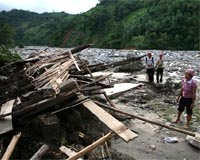| . |  |
. |
Melbourne FL (SPX) Jun 09, 2009 Florida Institute of Technology researchers are trying to solve one of the great mysteries in nature: how thunderstorms make lightning. Because, in principle, lightning is a big spark it should behave like other sparks-like the ones created when we touch a door knob on a dry day. Scientists have accumulated evidence, however, that lightning sometimes behaves in very un-spark-like ways. Lightning can start in regions of thunderstorms that have relatively low electric fields and, so, should create no sparks. Because lightning obviously is made by thunderstorms, scientists are left wondering what they are missing. Three such scientists, Joseph Dwyer and Hamid Rassoul from Florida Tech and Martin Uman from the University of Florida, recently published a paper in the Journal of Geophysical Research titled, "Remote measurement of thunderstorm electrostatic fields." It describes their new technique to remotely measure thunderstorm electric fields on the ground. By measuring small radio pulses made by cosmic-rays passing through these storms, they calculate that they can reconstruct the electric fields along the high-energy particle's paths. This could allow them to measure any lightning initiation pockets that might exist. One idea is that thunderstorms generate big electric fields capable of making sparks, but those strong fields are localized in very small pockets-too small to be easily detected by the balloons and aircraft sent into thunderclouds to measure the fields. Although this seems reasonable, the problem has been how to test it. Indeed, for decades scientists have struggled in vain to find such pockets where lightning might be initiated. "Cosmic-rays are high-energy particles from outer space that constantly rain down on our planet. They form a natural probe for measuring thunderstorms," explained Dwyer, professor of physics and space sciences, who is leading the research effort. "Thunderstorms are big, violent, and dangerous places. Cosmic-ray air showers allow us to study them from a relatively safe location on the ground." "It's a daunting task to find these high field regions," explained Rassoul, professor of physics and space sciences. "Thunderstorms are large and the chance that a balloon would find its way into exactly the right place at the right time to catch lightning initiation is small." This summer at the UF/Florida Tech International Center for Lightning Research and Testing at Camp Blanding, Fla., scientists are conducting experiments to search for these lightning initiation pockets. If successful, researchers will be closer to understanding lightning, a phenomenon that has mystified people for thousands of years. Share This Article With Planet Earth
Related Links Florida Institute of Technology Weather News at TerraDaily.com
 Five killed as storms batter northern Vietnam
Five killed as storms batter northern VietnamHanoi (AFP) May 28, 2009 Five people, including three children, were killed as heavy rain lashed Vietnam's northern Nghe An province, an official said Thursday. "The five were killed in a landslide overnight on Tuesday in the Yen Tinh district," said Vi Van Hoi, vice-president of Tuong Duong district council. "More than 800 millimetres (31 inches) of rain has fallen on the province over the last few days and it ... read more |
|
| The content herein, unless otherwise known to be public domain, are Copyright 1995-2009 - SpaceDaily. AFP and UPI Wire Stories are copyright Agence France-Presse and United Press International. ESA Portal Reports are copyright European Space Agency. All NASA sourced material is public domain. Additional copyrights may apply in whole or part to other bona fide parties. Advertising does not imply endorsement,agreement or approval of any opinions, statements or information provided by SpaceDaily on any Web page published or hosted by SpaceDaily. Privacy Statement |